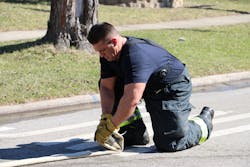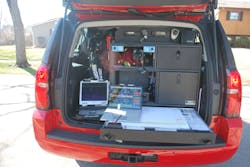Download the full PDF SMARTER: Advancing Health-Related Technology here.
Firefighter Cadet Steven Whitfield was a member of Houston Fire Department (HFD) cadet class 2015G. On the morning of March 31, 2016, Cadet Whitfield’s class was participating in a training evolution in the “Survival House” located on the campus of the Val Jahnke Training Facility (VJTF). Cadets, encapsulated in full structural PPE while wearing SCBA, maneuvered themselves through the structure in a non-immediately dangerous to life and health (IDLH) environment, under the supervision of training academy instructors.
At approximately 11:07 a.m., Whitfield, nearing the end of the course, stopped moving, which activated his personal alert safety system (PASS) device. Within seconds, instructors removed Whitfield from the course and started providing advanced life support accompanied with active cooling. He was then transported to the hospital and pronounced dead just before 1 p.m.
Seconds before collapsing, Whitfield spoke with instructors and was able to confirm his orientation to the environment and his surroundings. After having his cognitive ability evaluated, Whitfield remained on the course to complete the evolution. Whitfield was 10 feet from the exit when he collapsed.
What went wrong?
Men and women who serve in this industry understand the inherent risk associated with saving lives and protecting property. It is part of the job. Training, on the other hand, should not carry the same level of risk. Instructors carefully script training evolutions designed to maximize a cadet’s potential for success while minimizing the cadet’s exposure to risk. The bottom line is very simple: Losing a life during a training evolution is unacceptable.
The days following the loss of Whitfield at the training academy were incredibly difficult for everyone. Investigation into the line-of-duty death (LODD) began immediately. Cadets from class 2015G were questioned about the incident along with the instructors who were working in the Survival House that morning. Although I was not personally involved with the training evolutions, I found myself plagued by two simple questions: Why did this happen? Was it preventable?
The why was answered within the autopsy report. The cause of death was hyperthermia and dehydration. The importance of hydration and a proper diet is introduced to the cadets prior to stepping foot on campus as a firefighter trainee during the conditional job offer. Once on campus, cadet instructors reinforce the importance of nutrition and hydration throughout the training program. Any problems with hydration were not due to a lack of effort on the part of academy personnel. As such, the only question left to ponder was if this incident was preventable.
Monitoring the body
The fixation on prevention started to shift early in the process. Prevention is really an extension of predictability. If we can accurately predict that something will occur, then we should be able to put mechanisms in place to prevent it from happening. Unfortunately, the ability to predict hyperthermia in a firefighter in a full PPE ensemble seemed difficult. A temperature can be obtained pre- and post-event, but not during the evolution. We did not have technology that was capable of providing a temperature reading of a firefighter who was wearing a full set of bunker gear.
We looked into a number of companies that sold wearable solutions, but the deeper we dove into the issue, the more we realized we had a another issue: Not only did we need to be able to identify the physiological status of a firefighter, we also had to transmit the information back to someone who could provide oversight on the issue. We needed to be alerted to a problem before it had the opportunity to become an emergency. Ultimately, this led us to Zephyr and their Physiological Status Monitoring (PSM) System. Zephyr has partnered with Globe to integrate its PSM into a fire-resistant base layer shirt.
Today, the training academy of the HFD has the ability to deploy two Zephyr PSM systems on campus. Each system can monitor up to 50 participants. Currently, the system is deployed to oversee the physical training of cadet firefighters when they are participating in evolutions that require the use of full PPE. A member of the VJTF Professional Development staff is dedicated to overseeing the entire PSM program. Engineer Operator Vidal Molina is responsible for deploying the system, monitoring the cadets during the training evolution, alerting instructors when there is cause for concern, and collecting the data for each evolution. The HFD uses the data collected to fine-tune criteria for removal from a training evolution. The removal criteria is evaluated on a case-by-cases basis and is measured against the baseline numbers of the participant.
A vital tool
We are working with the SMARTER research team to better understand the physiological strain associated with firefighting training scenarios and to help refine protocols to use wearable technology to keep cadets safer during these training scenarios. Physiological status monitoring is a potential technological solution that helps instructors “see” how the recruits are doing. We do not believe that physiological monitoring can replace a vigilant instructor, but it can be a useful tool to assist those who are committed to safely training firefighters in our care.
Read more about the SMARTER project and related studies at skidmore.edu/responder.
To learn more about the Globe by MSA WASP System, visit globeturnoutgear.com/innovation/wasp.
More from SMARTER: Advancing Health-Related Technology
Jeffery King
Jeffery L. King, BSFS, MSESM, CTO, FSCEO, is the district chief of fire training for Cy-Fair Volunteer Fire Department and a senior captain in the Houston Fire Department. He holds a bachelor’s degree in fire science and a master’s in Emergency Services Management. He is a chief training officer and a fire service chief executive officer.








